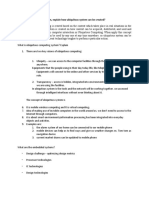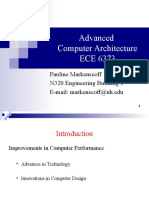0 ratings0% found this document useful (0 votes)
4 viewsComputer Architecture
Uploaded by
darshan.jCopyright
© © All Rights Reserved
Available Formats
Download as DOCX, PDF, TXT or read online on Scribd
0 ratings0% found this document useful (0 votes)
4 viewsComputer Architecture
Uploaded by
darshan.jCopyright
© © All Rights Reserved
Available Formats
Download as DOCX, PDF, TXT or read online on Scribd
You are on page 1/ 4
COMPUTER ARCHITECTURE
Computer architecture is the design and organization of the fundamental components in a
computer system, defining how they interact to perform tasks. It includes the structure and
functionality of the processor, memory hierarchy, input/output (I/O) systems, and the
interconnection between components.
1.Central Processing Unit (CPU): The CPU, also referred to as the “central” or “main” processor,
is a complex set of electronic circuitry that runs the machine’s operating system and apps.
Control Unit (CU): The control unit orchestrates the fetching, decoding, and execution of
instructions. It determines the flow of data between the CPU and other components by
interpreting the commands in the instruction set and signaling the ALU, registers, and other
parts to perform tasks in sequence.
Arithmetic Logic Unit (ALU): Executes arithmetic and logic operations.
Registers: These are Small, fast storage locations within the CPU for immediate data processing.
There are different types of registers, such as data registers (to store operands), address
registers (to store memory addresses), and special-purpose registers like the program counter
(PC) that keeps track of instruction execution.
Cache Memory: Cache is a small, high-speed memory between the CPU and main memory,
storing frequently accessed data to reduce latency. It’s usually divided into levels: L1 Cache:
Closest to the CPU, with the smallest size and highest speed. L2 Cache: Larger and slightly
slower, usually shared by multiple cores. L3 Cache: Further from the core but larger in size,
often shared across cores in multi-core processors.
2.Memory Hierarchy: The memory hierarchy is organized to minimize access time, with each
level being progressively larger and slower: Registers, Cache,
Main Memory: RAM holds data and programs actively in use. It’s volatile, meaning data is lost
when power is turned off. RAM’s speed impacts overall system performance, as it feeds
instructions and data to the CPU cache.
Secondary Storage (SSD, HDD): These are non-volatile memory types that store data long-term.
Solid State Drives (SSDs) are faster than Hard Disk Drives (HDDs) due to their lack of moving
parts, making SSDs essential in modern systems, especially where fast data access is crucial.
3. Input/Output (I/O) System: The I/O system manages the exchange of data between the
computer and external devices (e.g., keyboards, displays, storage drives). The I/O subsystem
includes components such as: I/O Controllers: Specialized processors that manage
communication with peripheral devices.
Buses: Buses carry data between the CPU, memory, and I/O devices. Types of buses include:
Address Bus: Carries memory addresses from the CPU to other components. Data Bus:
Transports actual data between the CPU, memory, and I/O. Control Bus: Transmits control
signals like read/write commands.
4. Bus Architecture: Buses are essential for data flow and often have a significant impact on
system performance. Modern systems use high-speed buses like PCIe (Peripheral Component
Interconnect Express), allowing high bandwidth communication for devices like GPUs, SSDs, and
network cards.
5. Instruction Set Architecture (ISA): An ISA is the set of instructions that the CPU can execute.
Different ISAs provide unique benefits:
CISC (Complex Instruction Set Computing): CISC architectures have many complex instructions,
each potentially performing multiple operations. This reduces the number of instructions a
program needs but can increase decoding complexity. It’s typically found in older architectures
like x86.
RISC (Reduced Instruction Set Computing): RISC architectures focus on simpler instructions,
each completing in a single cycle. This approach simplifies the CPU design and speeds up
processing, making RISC common in modern designs (e.g., ARM processors used in mobile
devices).
Modern Extensions: Many CPUs today combine aspects of RISC and CISC, with extensions like
SIMD (Single Instruction, Multiple Data) and vector processing to handle multimedia, graphics,
and scientific computations.
6.Pipeline and Parallelism: Techniques to improve CPU efficiency and speed, such as dividing
tasks into pipeline stages or employing multiple processors to execute instructions
simultaneously.
In the context of memory and storage, specific architectural elements are critical:
Memory Controller: Manages data flow between the CPU and memory, optimizing for speed
and efficiency.
Error Correction: Techniques like ECC (Error Correction Code) detect and correct errors in
memory, crucial in applications requiring high reliability.
Non-Volatile Memory Architecture: Architectures like NAND flash and NOR flash are designed
with durability and low power in mind, especially important in ASICs for storage.
Trends and Developments
Modern computer architecture is also increasingly focused on areas such as low-power design,
the incorporation of specialized processing units (like GPUs and TPUs), and support for AI and
machine learning tasks.
A Graphics Processing Unit (GPU) is a specialized processor optimized for parallel computing,
essential for rendering graphics, and widely used in applications like artificial intelligence,
scientific computing, and data analytics.
Core Components of a GPU: Stream Processors (Cores): Thousands of simple cores handle
multiple tasks concurrently, ideal for parallel processing.
Memory (VRAM): Dedicated high-speed memory (like GDDR or HBM) stores data for rapid
access, optimized for graphics and compute workloads.
Warp/Thread Scheduler: Manages threads by grouping them into "warps," efficiently
distributing work across cores.
GPU vs. CPU: While CPUs are optimized for sequential, single-threaded tasks and low-latency
execution, GPUs excel at handling parallel tasks and high-throughput computing: Parallelism:
GPUs have many small cores, ideal for parallel tasks (e.g., image processing, neural networks).
Throughput Focus: Optimized for high data volume (throughput) rather than low-latency, single-
task execution.
Key GPU Technologies:
CUDA(Compute Unified Device Architecture): NVIDIA's API enabling general-purpose parallel
processing on GPUs.
OpenCL (Open Computing Language): Open standard for running code on various GPUs, CPUs,
and FPGAs.
Trends and Future Directions: AI-Specific Enhancements: Increasing AI cores (like Tensor Cores)
for efficient neural network processing.
OPERATING SYSTEM FUNDAMENTALS
Operating System (OS) Fundamentals focus on the essential concepts and functions of an OS,
which acts as an intermediary between hardware and software, managing system resources and
providing a user interface.
1. An OS is system software that: Manages Hardware Resources: CPU, memory, storage, I/O
devices. Provides Services: Interfaces for running applications and enabling user interaction.
Ensures Efficient Operation: Optimizes resource usage, ensuring multitasking and
responsiveness.
2. Functions of an Operating System:
a. Process Management: Processes: An instance of a running program. Tasks: Scheduling,
Assigns CPU time to processes. Context Switching, Switches between processes efficiently. Inter-
Process Communication (IPC), Allows processes to share data.
b. Memory Management: Allocating memory to processes, Ensuring safe memory access, Using
virtual memory for efficient utilization. Techniques: Paging, Divides memory into fixed-size
blocks. Segmentation, Divides memory into variable-size blocks based on logical divisions.
c. File System Management: Manages data storage and retrieval on devices like HDDs, SSDs,
etc., Organizes data into files and directories, Tracks file metadata (permissions, ownership,
size).
d. Device Management: Manages communication with peripheral devices through device
drivers. Handles I/O operations using buffers, queues, and interrupts.
e. User Interface: Provides a command-line interface (CLI) or graphical user interface (GUI) for
interaction. Examples: Linux (CLI), Windows (GUI).
3. Types of Operating Systems: Batch OS, Time-Sharing OS, Real-Time OS (RTOS, Distributed OS,
Embedded OS.
4. OS Architectures: Monolithic Kernel, Microkernel, Hybrid Kernel.
Examples of Modern Operating Systems:
Windows: General-purpose OS with a GUI.
Linux: Open-source, widely used in servers and embedded systems.
MacOS: UNIX-based OS optimized for Apple hardware.
Android/iOS: Mobile operating systems with touch-based interfaces.
RTOS: VxWorks, FreeRTOS for real-time applications.
7. Importance of Operating Systems: Facilitates hardware-software interaction. Ensures
efficient resource utilization. Provides security and stability. Supports multitasking and user
convenience.
You might also like
- How To Reset Epson L5190 With Adjustment Program (Solve A Printer's Ink Pad Is at The End of Its Service Life)No ratings yetHow To Reset Epson L5190 With Adjustment Program (Solve A Printer's Ink Pad Is at The End of Its Service Life)6 pages
- Philips SONOS PC Model 77471 C D (D.2.1) Field Service ManualNo ratings yetPhilips SONOS PC Model 77471 C D (D.2.1) Field Service Manual319 pages
- Fundamentals of Computer Assignment ReportNo ratings yetFundamentals of Computer Assignment Report27 pages
- Computer Architecture 1.1. Basic Computer Arch...No ratings yetComputer Architecture 1.1. Basic Computer Arch...14 pages
- 1- Introduction to Computer ArchitectureNo ratings yet1- Introduction to Computer Architecture9 pages
- FastTrack of OS - OneDay (6H) - May 2022 - Ver 1No ratings yetFastTrack of OS - OneDay (6H) - May 2022 - Ver 1102 pages
- lect1-2 Introduction to Computer Hardware and ArchitectureNo ratings yetlect1-2 Introduction to Computer Hardware and Architecture19 pages
- Advanced Computer Architecture: CSE-401 ENo ratings yetAdvanced Computer Architecture: CSE-401 E71 pages
- Computer Science Crash Course - Session 1No ratings yetComputer Science Crash Course - Session 122 pages
- Computer Organization - MIPS Assembly Part 1No ratings yetComputer Organization - MIPS Assembly Part 16 pages
- What Is Ubiquitous System, Explain How Ubiquitous System Can Be Created?No ratings yetWhat Is Ubiquitous System, Explain How Ubiquitous System Can Be Created?8 pages
- BENC 4453: Computer Architecture: Computing OverviewNo ratings yetBENC 4453: Computer Architecture: Computing Overview37 pages
- Advanced Computer Architecture ECE 6373: Pauline Markenscoff N320 Engineering Building 1 E-Mail: Markenscoff@uh - EduNo ratings yetAdvanced Computer Architecture ECE 6373: Pauline Markenscoff N320 Engineering Building 1 E-Mail: Markenscoff@uh - Edu151 pages
- Hardware&processor, OS BBA III SEM (ITB)No ratings yetHardware&processor, OS BBA III SEM (ITB)45 pages
- Computer Architecture Presentation UpdatedNo ratings yetComputer Architecture Presentation Updated12 pages
- Unit - I: Basic Structure of A Computer System Computer SystemNo ratings yetUnit - I: Basic Structure of A Computer System Computer System25 pages
- A Real Time Deep Learning Based Driver Monitoring SystemNo ratings yetA Real Time Deep Learning Based Driver Monitoring System6 pages
- 5.2 Activity Life Cycle, Broadcast Life CycleNo ratings yet5.2 Activity Life Cycle, Broadcast Life Cycle35 pages
- UniBeast_ Install macOS Catalina on Any Supported Intel-based PC _ tonymacx86.comNo ratings yetUniBeast_ Install macOS Catalina on Any Supported Intel-based PC _ tonymacx86.com9 pages
- Samara University College of Engineering and Technology Computer ScienceNo ratings yetSamara University College of Engineering and Technology Computer Science49 pages
- How To Reset Epson L5190 With Adjustment Program (Solve A Printer's Ink Pad Is at The End of Its Service Life)How To Reset Epson L5190 With Adjustment Program (Solve A Printer's Ink Pad Is at The End of Its Service Life)
- Philips SONOS PC Model 77471 C D (D.2.1) Field Service ManualPhilips SONOS PC Model 77471 C D (D.2.1) Field Service Manual
- lect1-2 Introduction to Computer Hardware and Architecturelect1-2 Introduction to Computer Hardware and Architecture
- What Is Ubiquitous System, Explain How Ubiquitous System Can Be Created?What Is Ubiquitous System, Explain How Ubiquitous System Can Be Created?
- BENC 4453: Computer Architecture: Computing OverviewBENC 4453: Computer Architecture: Computing Overview
- Advanced Computer Architecture ECE 6373: Pauline Markenscoff N320 Engineering Building 1 E-Mail: Markenscoff@uh - EduAdvanced Computer Architecture ECE 6373: Pauline Markenscoff N320 Engineering Building 1 E-Mail: Markenscoff@uh - Edu
- Unit - I: Basic Structure of A Computer System Computer SystemUnit - I: Basic Structure of A Computer System Computer System
- A Real Time Deep Learning Based Driver Monitoring SystemA Real Time Deep Learning Based Driver Monitoring System
- UniBeast_ Install macOS Catalina on Any Supported Intel-based PC _ tonymacx86.comUniBeast_ Install macOS Catalina on Any Supported Intel-based PC _ tonymacx86.com
- Samara University College of Engineering and Technology Computer ScienceSamara University College of Engineering and Technology Computer Science

























































































